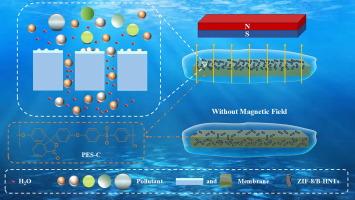Preparation of ZIF-8/Fe3O4 modified halloysite nanotubes blended ultrafiltration membranes via magnetic field regulation: Enhanced performance and efficient filler distribution
IF 8.1
1区 工程技术
Q1 ENGINEERING, CHEMICAL
引用次数: 0
Abstract
A substantial number of fillers tended to deposit and aggregate in the finger-like region of the ultrafiltration membrane (UF) during the phase immersion method, leading a waste of fillers and a significant decrease in various membrane properties. Consequently, effectively regulating the distribution of fillers within the membrane matrix emerged as a critical issue requiring urgent attention. In this study, ZIF-8-modified Fe3O4 halloysite nanotubes (ZIF-8/B-HNTs) were successfully synthesized and blended with PES-C. Utilizing the magnetic field, magnetized and non-magnetized membranes were prepared to investigate the impact of magnetic fields on filler distribution and membrane properties. The results indicated that the magnetic force facilitated the ZIF-8/B-HNTs composites to undergo directional migration towards the membrane surface along the direction of the magnetic field lines within the PES-C matrix, which not only achieved filler enrichment to enhance the utilization rate of fillers but also significantly enhanced various membrane properties. Specifically, the magnetized membrane with 0.5 wt% ZIF-8/B-HNTs composites achieved a maximum pure water flux of 590.4 L/m2h, and the magnetized membrane with 1.5 wt% ZIF-8/B-HNTs composites reduced water contact angle to 47.6° and flux recovery rate up to 89.6 %, while maintaining excellent retention capability for BSA (>95 %). Furthermore, due to the uniform distribution of ZIF-8/B-HNTs composites on the membrane surface, both magnetized and non-magnetized membranes with 1.5 wt% ZIF-8/B-HNTs composites exhibited high adsorption capacities and over 95 % rejection for three anionic dyes (EB, CR, CCB). These finding expanded the application range of UF membranes and provided guidance for precise regulation of membrane microstructures, enhancement of membrane properties and future development.


求助全文
约1分钟内获得全文
求助全文
来源期刊

Separation and Purification Technology
工程技术-工程:化工
CiteScore
14.00
自引率
12.80%
发文量
2347
审稿时长
43 days
期刊介绍:
Separation and Purification Technology is a premier journal committed to sharing innovative methods for separation and purification in chemical and environmental engineering, encompassing both homogeneous solutions and heterogeneous mixtures. Our scope includes the separation and/or purification of liquids, vapors, and gases, as well as carbon capture and separation techniques. However, it's important to note that methods solely intended for analytical purposes are not within the scope of the journal. Additionally, disciplines such as soil science, polymer science, and metallurgy fall outside the purview of Separation and Purification Technology. Join us in advancing the field of separation and purification methods for sustainable solutions in chemical and environmental engineering.
 求助内容:
求助内容: 应助结果提醒方式:
应助结果提醒方式:


